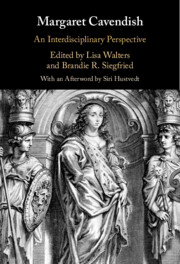Book contents
- Margaret Cavendish
- Margaret Cavendish
- Copyright page
- Contents
- Illustrations
- Notes on Contributors
- In Memoriam
- Acknowledgments
- Introduction
- Part I History of Science
- Part II Philosophy
- Part III Literature
- Chapter Eight Of Webs and Wonder
- Chapter Nine The Blazing World
- Chapter Ten Margaret Cavendish’s Prudence; or, Preservation and Transformation in Playes (1662) and Plays, Never Before Printed (1668)
- Chapter Eleven Lady Newcastle’s “Unsoiled Petticoats” and the Literary Reputation of Margaret Cavendish, 1652–1985
- Part IV Politics
- Part V New Directions
- Afterword
- Chronology of Works by Margaret Cavendish
- Select Bibliography
- Index
Chapter Eleven - Lady Newcastle’s “Unsoiled Petticoats” and the Literary Reputation of Margaret Cavendish, 1652–1985
from Part III - Literature
Published online by Cambridge University Press: 28 April 2022
- Margaret Cavendish
- Margaret Cavendish
- Copyright page
- Contents
- Illustrations
- Notes on Contributors
- In Memoriam
- Acknowledgments
- Introduction
- Part I History of Science
- Part II Philosophy
- Part III Literature
- Chapter Eight Of Webs and Wonder
- Chapter Nine The Blazing World
- Chapter Ten Margaret Cavendish’s Prudence; or, Preservation and Transformation in Playes (1662) and Plays, Never Before Printed (1668)
- Chapter Eleven Lady Newcastle’s “Unsoiled Petticoats” and the Literary Reputation of Margaret Cavendish, 1652–1985
- Part IV Politics
- Part V New Directions
- Afterword
- Chronology of Works by Margaret Cavendish
- Select Bibliography
- Index
Summary
There are two major threads in the 350-year history of Cavendish’s literary reputation, both deriving from views of her life. In the first thread, she was a highly virtuous woman and a passionate writer, though what she wrote suffered from her poor education and lack of discipline. Her virtue was manifest in her biography of her husband and her passion, poor education, and lack of discipline apparent in her poetry. In the second and less-well-known thread, she had an eye for young men and included objectionable passages in her drama and poetry. Both threads are related to a set of categories historically used to evaluate women writers. Cavendish, thus, was like Katherine Philips who also was understood to be highly virtuous and like Aphra Behn who was thought to have written passionate but objectionable drama and verse. Largely outside of the major threads are observations offered by Samuel Pepys, who reacted to Cavendish as a celebrity. Her most important and nuanced critic was Virginia Woolf, who owed something to both threads and who wrote with a touch of irony. Evidence suggests that William Wordsworth and Horace Walpole knew and were influenced by Cavendish’s writing.
Keywords
- Type
- Chapter
- Information
- Margaret CavendishAn Interdisciplinary Perspective, pp. 173 - 186Publisher: Cambridge University PressPrint publication year: 2022
- 1
- Cited by

